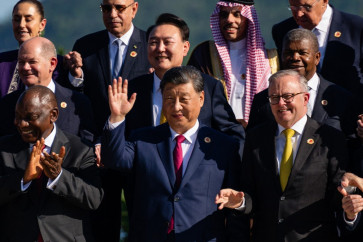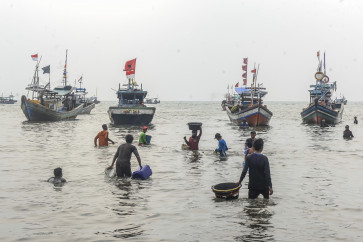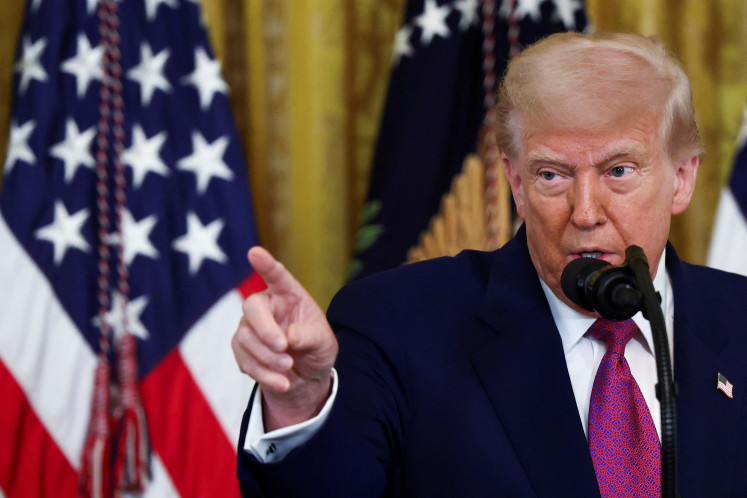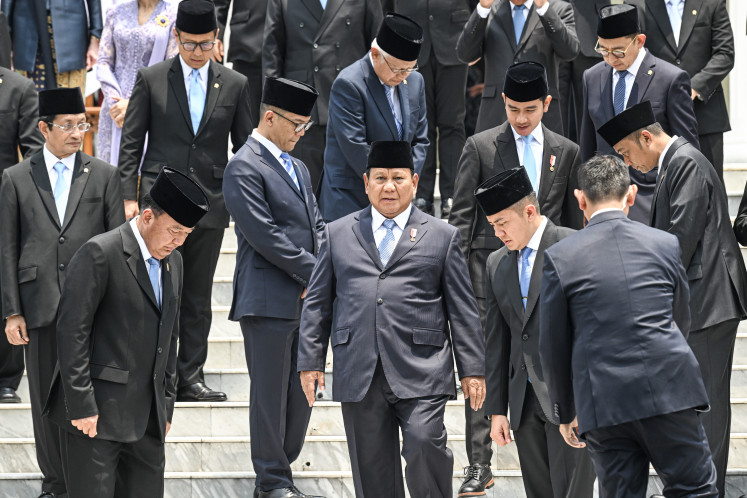Popular Reads
Top Results
Can't find what you're looking for?
View all search resultsPopular Reads
Top Results
Can't find what you're looking for?
View all search resultsGetting Personal: Eko Nugroho: Recording History through Art
JP/Bambang MuryantoA crowd packed the studio at the Institut Francais Indonesia in Yogyakarta
Change text size
Gift Premium Articles
to Anyone
JP/Bambang Muryanto
A crowd packed the studio at the Institut Francais Indonesia in Yogyakarta. The people were watching a contemporary Wayang Bocor shadow puppet show entitled Semelah, the latest work by Indonesia’s multitalented artist Eko Nugroho that will tour several cities in the United States this January.
Here, the word “semelah” — derived from the Javanese pronunciation of bismillah (in the name of God) — visualizes the assimilation of Islam by Javanese people.
Using shadow puppets and various art forms as media, Eko wished to showcase the face of Islam in Java — hospitable and capable of assimilating with local cultures, but not through violence.
“Islam in Indonesia is not only a religion but has also become a culture,” said the 40-year-old artist.
Eko is renowned for his unique creations, characterized by “peculiar” visual human forms wearing certain costumes with masks, machines, or alien heads while “narrating” current social issues.
In five years, between 2000 and 2015, the father of two had held 14 exhibitions and taken part in eight artist residencies abroad, getting rave reviews in various media.
One of his designs, Republik Tropis (Tropical Republic), adorned the scarves of Louis Vuitton for the 2013 fall and winter collection. Only 500 of the scarves were produced and they sold for about US$1,000 each.
“I got a royalty from each of the scarves sold,” said Eko in his house-studio in Bantul, Yogyakarta.
His large studio seems to shrink as most of its space stores his works: paintings, embroideries and sculptures. Two large embroideries — Her Tears and Fake Democracy Brings Fabulous Prosperity – are hanging on the walls.
After pursuing his artistic career for more than a decade, he may have earned fame and fortune but he had undertaken a long journey to be where he is now.
His family, living in Prawirodirjan, a settlement on the banks of the Code River, doubted if the art world could offer him a decent livelihood.
After finishing senior high school, Eko insisted on studying at the Indonesian Arts Institute (ISI) in Yogyakarta, although his father wanted him to do other jobs.
As a child, he was so fond of drawing that, as his mother related, his neighbors were angry to see their walls sketched with a roof-tile chip.
His parents finally allowed him to attend the college on the condition he should pay the tuition himself.
Eko recalled he started doing casual work while studying. “I frequently helped my grandmother who was selling food at Beringharjo Market. Occasionally I did manual work, like helping prepare art displays,” recalled the first of five siblings.
He also drew cartoons and sent them to media in Yogyakarta. His comics were considerably influenced by characters in children’s stories on TV, like Satria Baja Hitam (Black Steel Knight), Gaban and Google Five.
“I like masks, too. In college I began exploring masks and costumes, which are relevant to our arts,” he says.
With his friends, he has also published a non-mainstream graphic novel called Daging Tumbuh (Growing Flesh), which now becomes the brand name of the merchandise he sold from a shop in his house.
Eko first tried his embroideries when he was actively engaged in creating murals, by attaching small pieces in public spaces. Later, he created larger embroidered pictures, while also venturing into sculptures and other objects like helmets as his media of expression, which were frequently presented together in installation art forms.
In an interview with Enin Supriyanto for the book, Eko (Space) Nugroho (2011), Eko said his artistic career began to shine when he held an exhibition called “Bercerobong” (Like A Chimney) at Cemeti Art House in 2002.
“It was my first solo display. Cemeti Art House has a significant international reputation in Indonesia. It was the turning point of my global visual art career,” he said.
He entered performance art in 2008 by introducing Wayang Bocor, which also involves shadow puppet masters, theater players and musicians. Through this medium, Eko puts across clear messages that cannot be visually communicated through his other works like paintings, which are more difficult to grasp for their abstract nature.
His works are also critical of the government and the prevailing socio-political realities, showcasing his wish to be a narrator who bears witness to his era — recording various important events in his creations to serve as a mirror for everybody, including himself.
In his “This Republic Needs More Semeleh” exhibition at Ark Gallery, Yogyakarta (2011), Eko raised his concern. In Javanese culture, semeleh means patience, sincerity and reflection on what has happened.
“The country’s absurdity becomes an important part of criticism of a satirical and ridiculous nature. I’m criticizing myself, so are you, they and we all. Many things are ludicrous in the incidents and events occurring in this country, which has been praised by [legendary band] Koes Plus, made [first president] Sukarno feel proud and later was destroyed by terrorists,” he wrote.
Among his embroidered pictures on display is one that depicts a bird with the title Selamat datang kembali rasisme (Welcome back racism). Corruption that is still ingrained in Indonesia was also spotlighted. For this reason, almost every human figure is portrayed with hands that resemble crab pincers or scissors. “They symbolize the human behavior of desiring something in a short-cut, instant way, by corruption,” he said.
In introducing the exhibition, art curator Alia Swastika said Eko’s artistic pieces could be easily recognized from their paradoxes emerging from his spirit of spontaneous creation. “He has almost never ceased [his observation] amid the political circumstances around him,” she wrote.
Eko’s criticism is based on analytical judgments. He used a cultural approach in “This Republic”.
In another work, he could be structuralist — as shown in Fake Democracy, in which he denounced true democracy because those holding political power are always manipulated by conglomerates.
Eko also pays special attention to children by sparing time to manage a painting course for kids called the Eko Nugroho Art Class, now with 50 students.
He said the course was not designed to make children win painting competitions, but rather to serve more as recreation while learning creativity and composition.
“At least when they grow up they can arrange the composition of their clothes or rooms,” said Eko, who was once a primary school teacher.
His studio is also virtually a school for those wishing to learn arts, how to prepare exhibitions or performances and their management. To date, about 30 people are involved in the diverse activities carried out by Eko.
When he’s in a good mood for painting, he can finish five to six pieces in a month, but he may also produce none in a year. Before painting, he usually takes a walk or cycles around the village.
“He can also paint after buying toys in the market, especially masks, which are later arranged to build up his mood,” said Eko Nugroho Studio manager Oki Permatasari.
Eko searches for masks wherever he goes and they are present in most of his works, covering people’s faces to giving rise to social problems. He even exhibited them in Singapore in 2013, entitling the show “We Are What We Mask”.
In the exhibition’s introduction, art expert Adeline Ooi wrote that masks had been an integral part of Eko’s creations. In Ooi’s view, “to mask” can be to hide or take cover. The masked face symbolizes man’s inherent “two-facedness, the ability to change identities, conform and adopt a new persona for protection or as a form of disguise and transformation”.
People can have their own interpretation, but Eko has his own reason for using masks. “I don’t want to pass judgment on somebody. Such cases can happen to anybody in the future. History always repeats itself,” he said.










